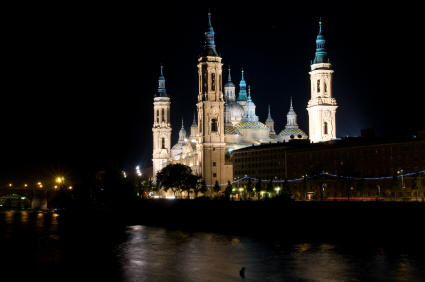 Zaragoza is the fifth largest city in Spain and capital of the Aragon region. It is situated in the northeast of Spain, roughly halfway between Madrid and Barcelona. The city has been relatively untouched by tourism, although this is now likely to change with the recent opening of a new high-speed rail link from Madrid. Zaragoza has some notable historic monuments, including a Moorish palace and several fine churches. There are also many tapas bars, cafes and restaurants, while Zaragoza's 40,000 students help to give the city a lively feel.
Zaragoza is the fifth largest city in Spain and capital of the Aragon region. It is situated in the northeast of Spain, roughly halfway between Madrid and Barcelona. The city has been relatively untouched by tourism, although this is now likely to change with the recent opening of a new high-speed rail link from Madrid. Zaragoza has some notable historic monuments, including a Moorish palace and several fine churches. There are also many tapas bars, cafes and restaurants, while Zaragoza's 40,000 students help to give the city a lively feel.
The Romans founded Zaragoza around 2,000 years ago, and the city takes its name from the Roman emperor Caesar Augusta. Zaragoza was ruled by the Beni-Hud dynasty in the 11th century. Despite having a reputation as a Christian hero, the legendary El Cid was in fact a mercenary leader who fought for the Islamic Beni Huds during this time. The city is also famous for resisting Napoleonic forces during the great sieges of the early 19th century.
The majority of Zaragoza's tourist attractions, including La Lonja, El Pilar and La Seo cathedral, are situated around the Plaza del Pilar. Between this large public square and the River Ebro is the huge Basilica de Nuestra Senora del Pilar. This impressive Baroque church has a large central dome surrounded by 10 smaller domes, with four tall towers in each corner. It was built to honour the Virgin of the Apostle who, according to legend, appeared before St James on this site in AD40. The basilica's interior is notable for its carvings and elaborate frescoes, with the highlight being a series of paintings by Francisco de Goya within the central dome. One of Spain's best-loved painters, Goya was born in 1746 in a small village just outside Zaragoza. A couple of bombs were dropped on the church during the Spanish Civil War but fortunately they failed to explode.
The Gothic cathedral of La Seo was built on the site of Islamic mosque. Its museum contains many treasures, such as paintings, tapestries and sculptures. A short distance from La Seo is the Renaissance exchange of La Lonja, constructed from thousands of small bricks. La Lonja's interior is notable its magnificent stone ornamentation. The Palacio de la Aljaferia, built during the 11th century, is located to the west of the city centre. Although it has been modified many times over the years, this Moorish palace still retains its original mosque and courtyard. The elaborately carved ceiling on the first floor contains images of the Catholic monarchs, Ferdinand and Isabella.
There are some great views of the city from the much-photographed bridge, Puente de Piedra, which spans the River Ebro. Constructed in 1813, the bridge contains elements of Basque, French and Italian architecture. Other historic attractions in Zaragoza include the 18th century Puerta del Carmen, once part of the city walls, and the Arab Baths dating from the 13th century. Children will enjoy the science museum and the amusement park, which is set within attractive pine groves.